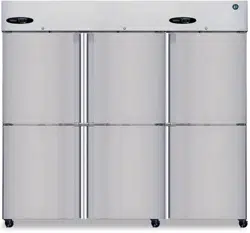Loading ...
Loading ...
Loading ...

16
E. Defrost
1. Refrigerators
Refrigerators use an off-cycle, time-initiated defrost and defrost once every 2 hours.
When the defrost thermistor warms to44°F (6.6°C), defrost terminates. The minimum
defrost time is 20 minutes and the maximum defrost time is 1 hour. Cabinet temperature
is displayed during defrost.
2. Freezers
Freezers use a heated, temperature/time-initiated defrost. Once the defrost thermistor
cools to 32°F (0°C), the 4-hour cumulative compressor run timer starts. When the 5-hour
cumulative compressor run timer terminates, defrost begins. Cabinet temperature is not
displayed during defrost; "dEF" is displayed in its place. When the defrost thermistor
warms to 45°F (7°C), defrost terminates. A 3-minute compressor delay timer, a 7-minute
evaporator fan motor delay timer, and an 18-minute temperature display delay timer start.
As the delay timers terminate, the related components energize. Note that the 7-minute
evaporator fan motor delay time is a maximum; if the defrost thermistor cools to 25°F
(-3.9°C) before the 7-minute evaporator fan motor delay timer terminates, the evaporator
fan motor will energize. Freezers have a minimum defrost interval of 4 hours. The
minimum defrost time is 5 minutes and the maximum defrost time is 1 hour.
3. Manual Defrost
To initiate a manual defrost, press the manual defrost button.
F. Food Storage
WARNING
• This appliance is designed only for storage of food. Employ sanitary methods. Use
for any other purposes (for example, storage of chemicals or medical supplies
such as vaccine and serum) could cause deterioration of stored items.
• Do not block the cabinet air inlet or outlet, otherwise cooling performance may be
reduced.
• Do not tightly pack the cabinet. Allow some space between items to ensure good
air ow. Also allow space between items and interior surfaces.
• Do not place any product on the oor of the cabinet. All product must be placed on
properly installed shelves.
• Do not put warm or hot foods in the cabinet. Let them cool rst, or they will raise
the cabinet temperature and could deteriorate other foods in the cabinet or
overload the appliance.
• All foods should be wrapped in plastic lm or stored in sealed containers.
Otherwise foods may dry up, pass their smells onto other foods, cause frost
to develop, result in poor appliance performance, or increase the likelihood of
cross-contamination. Certain dressings and food ingredients, if not stored in
sealed containers, may accelerate corrosion of the evaporator, resulting in failure.
• Do not store items near the air outlet. They might freeze up and crack or break
causing a risk of injury or contamination of other food.
• To maintain proper product temperature on glass door models, allow at least 5"
(13cm) of space between items and LED light strips when lights are in use.
Loading ...
Loading ...
Loading ...
